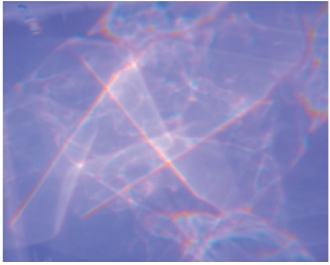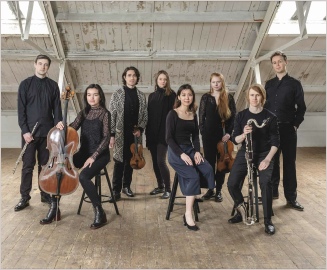Another Timbre TimHarrisonbre

at215 Catherine Lamb ‘parallaxis forma’
Three compositions by Catherine Lamb
1 - color residua (2016/2020) 10:50
Explore Ensemble & Exaudi Vocal Ensemble
2 - pulse/shade (2014) 19:00
Lotte Betts-Dean (multitracked voice)
3 - parallaxis forma (2016) 26:11
Explore Ensemble & Lotte Betts-Dean (voice)

Catherine Lamb
Interview with Nicholas Moroz of Explore Ensemble
As artistic director of Explore Ensemble, you've chosen to play a few of Cat Lamb's pieces in concert now. What is it that draws you to her music, and in particular to her pieces that use voice?
There are many things that for me make Cat's music special. I guess first of all, it's music I turn to if I want a certain feeling/mood or experience, of time, and of sound. I've been lucky to hear a few of her recent pieces live, like the JACK Quartet playing her 'divisio spiralis' at Wigmore Hall, and of course the concerts of Explore Ensemble where we've played 'parallaxis forma' with vocalist Lotte Betts-Dean, when I also played electric guitar. For me it's this balance between a kind of sensual or sonic richness and depth that comes from her radiant harmonic language, along with the slowness of time in her works.
As a listener I feel like she's very generous and gives you space to move your focus, like viewing a painting: you can get up close and get lost in the brushwork, but also go further back, sit down, and drink in the more ambient sensation of the work. People sometimes call it drone music, but for me that misses the entire point of her music, as I understand it. It's not about passively listening to some nice background music, but actually the opposite, about actively listening, and as a listener, being present and attending to sound in its smallest shifts in tone, colour, texture etc. If you listen closely, the long-form pieces in particular are incredible in where they take you. In some ways even, challenging.
With the vocal pieces in particular, I find the voice itself brings a whole new dimension of life to the music. Cat doesn't use words or texts but rather phonemes; she treats the voice like another instrument where the shifting timbres become expressive substances. In all three works on this album the singers shift between different vowel sounds, and these emphasise different clusters of overtones or formants in the timbre of the voice. It's an incredible approach to blending the voices with instruments, especially the strings. With the bowed strings, she asks the players to shift the bow between different positions on the string to get either a clear tone, or a noisier 'spectral' sound closer to the bridge, which brings out more of the upper overtones in the timbre, and mixes beautifully with the vocal formants.
What I also like about the voice in her works is that they bring an inherently human quality to the music, whereas sometimes with other instrumental works, not only her own, but all instrumental music that explores deep time with abstract material, there is a risk of alienation, or an impenetrable surface that’s hard to dig into. The voice injects the music with a delicate human presence that for me also heightens the emotional resonance of the works; abstract yet corporeal.
Cat originally composed 'pulse/shade' for a vocal ensemble, but you chose to produce a multi-tracked version with Lotte Betts-Dean's voice overlaid several times. What was the thinking here?
It was a bit of an experiment in response to the idea of the piece itself, to emphasise the shifts in vowel sounds: using the same singer means the vowel sounds will (in theory) be more consistent compared to using four different singers, and so the cumulative effect is to hear the vowel shifts with more clarity.
For what it's worth, I think it worked! When you listen and start to get lost in the mesmerising repetitions, especially as it slows down, I noticed more and more the dazzling overtones in various combinations. Lotte's voice really becomes almost like a synthesiser in its razor-sharp precision between different sounds, and the phonemes shine out, sometimes like lasers in their electronic-sounding pointedness.
The other experiment in the multi-track approach is about the structure of the piece. The premise of the piece is simple: one duo accelerates, another decelerates. Live, this is really hard to pace, especially between four different people. In the studio however, we were able to get something that was almost mechanically exact, and so, I think we managed to get a kind of idealised structure, especially in the middle part, because while humans are generally good at judging acceleration and vice versa at faster speeds, we’re less go at slower speeds (perhaps something to do with how the short time scale relate to our body movements, I wonder!), and so it's really tricky in a live situation to keep the slow central part evenly measured.
We recorded all four voices in one direction (accelerating), and then I edited things later to reverse thedirection of one of the duos so they decelerated, with the exception of the faster opening and end sections, which we recorded at the actual tempi. This means that each duo is a perfect mirror of each other in terms of structure, and there is actually a centre point where they align (9:14 on the recording!). I don't know if this is important for Cat, but I thought it was cool to produce it in this way and create this otherworldly or super-precise version which would be virtually impossible to achieve with four different singers performing it live.
Also, I can't help but think that Lotte, being Australian and having also grown up in Berlin, is the perfect singer for this kind of music, which is so dependent on subtle differences in vowel sounds!
That’s interesting. The beauty of Cat’s music for me is that even when it is following structural processes as they unfold, it somehow sounds organic, and you don’t have to know or think about the structure to enjoy the soundworld. Are the two pieces for voices and ensemble, ‘color residua’ and ‘parallaxis forma’, structured in a similar way to ‘pulse/shade’, or are they – as they sound to my non-musician ears – looser in this respect?
I think she has several works that explore more ‘architectural’ or numerically-determined formal structures. Besides the strict idea of the piece, ‘pulse/shade’ actually leaves the realisation of the structure quite open to the performers. But there are others like ‘wave/forming (astrum)’ which are, to my ears, stricter sounding. But the ensemble pieces on this album don’t have a single structural shape or direction, as I understand them.
My ears are like yours in picking up on a looser though very deliberate and carefully-considered unfolding of the music, principally as very slow melodies which, in their slowness and combination intoharmony, melt away into texture, creating overall a beautiful haze that constantly invites the listener tofeel their way between fore, middle, and background (again this idea of active listening and the metaphor of listening as viewing, seeing different perspectives…)
In ‘color residua’, the opening track on this album, there are four ‘residuals’ or sections that unfold where a composite melody emerges as it slowly hockets between the singers and strings. In ‘parallaxis forma’, the ensemble sustain notes that appear in voice, as well as extra harmony/texture/colour notes.
I think ‘parallaxis forma’ is a good example that reflects Cat’s interest in the long introduction style forms of Dhrupad music, which I believe are important to her. For example, notice how from the start, the piece very gradually introduces new melody notes in the voice, beginning with just tiny micro variations of the opening sung F, then two notes, three, four etc. By the end of the piece, or the penultimate section, the voice blooms with those gorgeous ascending scales that spiral upwards.

Explore Ensemble
